Home Decor
What Is the New Trend in Home Decor
Discover the "O" in home decor trends: from sculptural furniture to sustainable solutions, get ready for innovative and stylish ideas.
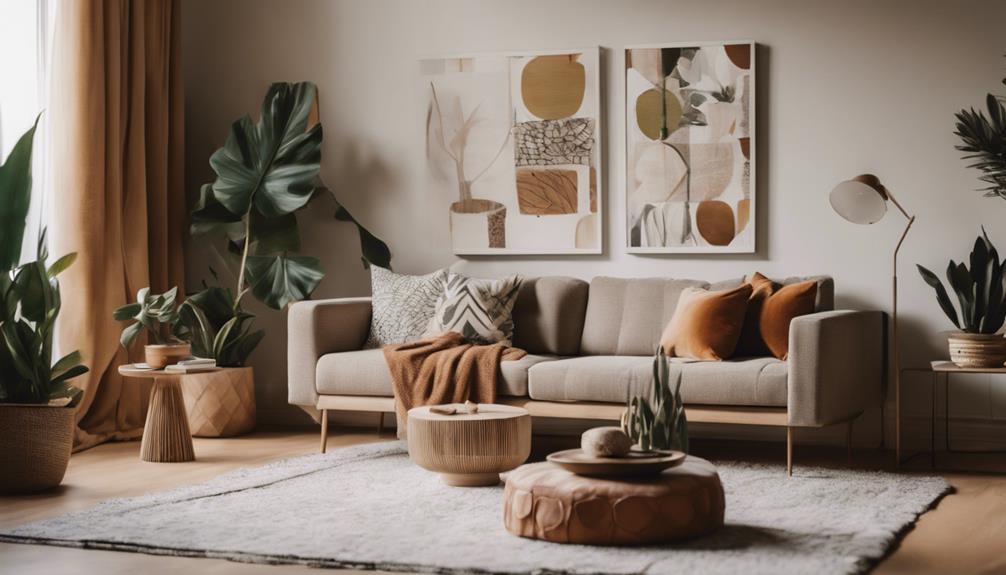
In home decor, the latest trends feature sculptural furniture, warm neutrals with textured elements, innovative sustainable solutions, playful accents, and a nostalgic touch from the seventies. Think unique shapes like the Aria sofas, cozy textures in delicate pinks and browns, and creative space-saving ideas. Explore ruffles and pop art-inspired designs for a contemporary vibe or embrace dark maximalism with tactile fabrics. Delve into the world of renewable materials and sustainability to create a greener, stylish space. Stay tuned for more insights on what's shaping interiors this year.
Key Takeaways
- Sculptural furniture and lighting like Tense pendant lights and Aria sofas are popular.
- Warm neutrals and textures such as delicate pinks and cozy browns dominate trends.
- Innovative design solutions focus on space-saving options and eco-friendly materials.
- Playful touches in decor, like ruffles and pop art-inspired designs, create a contemporary vibe.
- Seventies nostalgia with dark maximalism and tactile fabrics adds character to home design.
Sculptural Furniture and Lighting
Sculptural furniture and lighting have emerged as prominent elements in contemporary home decor, elevating interiors with their artistic and functional appeal.
The Tense pendant light and HAY Crate armchair are key trends in 2024, adding modern sophistication to living spaces. Aria sofas offer unique shapes and designs, making a statement in contemporary decor. These sculptural pieces not only enhance aesthetics but also provide practicality, with options like L-shaped and chaise sofas featuring hidden ottoman storage for added functionality.
In the domain of lighting fixtures, long, oblong pendants stand out by offering both functionality and decorative flair, serving as focal points while providing warm, flattering light. Gold-plated ceramics are on-trend, contributing to minimalist palettes and infusing spaces with artisanal touches.
The fusion of sculptural furniture and lighting brings a fresh, artistic vibe to interiors, creating a harmonious blend of form and function in modern homes.
Warm Neutrals and Textures
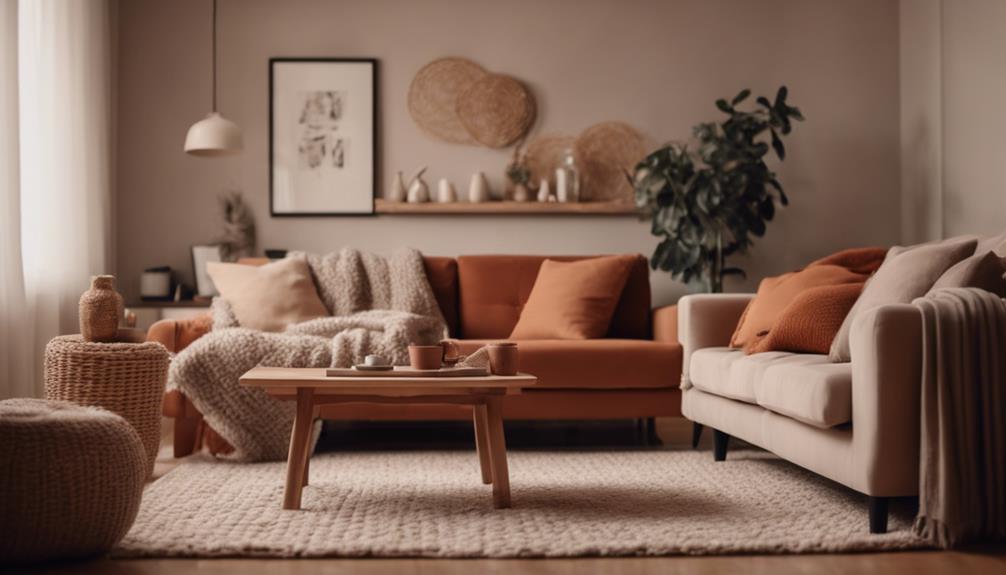
Warm neutrals like delicate pinks and cozy browns are key in creating a cozy ambiance in our living spaces. These earthy color palettes effortlessly blend with various decor styles, adding a touch of modernity and warmth.
Embracing tactile elements such as wood, fabric, and rugs elevates the design aesthetic, infusing rooms with depth and a welcoming feel.
Earthy Color Palettes
Delicate pinks and cozy browns are currently dominating the home decor scene with their earthy color palettes and inviting textures. These warm neutrals, along with soft yellows, create a modern aesthetic infused with warmth and sophistication.
Incorporating warm undertones in color schemes not only adds a contemporary touch but also brings a calming effect to living spaces. Earthy hues such as ochre, tan, taupe, and greys are key players in the domain of interior design, offering a nature-inspired tranquility.
Cozy Tactile Elements
With a harmonious blend of warm neutrals and inviting textures, our homes are transformed into cozy sanctuaries that exude a sense of comfort and sophistication. Natural materials like wood and fabric, combined with warm neutrals such as cozy browns and soft yellows, create a modern design aesthetic with warm undertones. Incorporating textural designs in living spaces through rugs and curtains enhances the richness of the room. Mixing materials like leather and wood adds to the welcoming atmosphere, making the space cozy and inviting. This trend in interior design focuses on creating a harmonious balance between warmth and elegance, providing a comforting and stylish environment for relaxation and entertainment.
| Natural Materials | Warm Neutrals | Textural Designs | Cozy Browns |
|---|---|---|---|
| Wood | Soft Browns | Rugs | Leather |
Innovative Design Solutions

We're seeing a rise in creative space-saving solutions and a growing interest in eco-friendly materials in home decor.
These innovative design solutions offer practical ways to enhance our living spaces while also being mindful of sustainability.
Creative Space-Saving Solutions
Incorporating innovative design solutions is essential for maximizing space in modern home decor trends. Utilizing space-saving solutions like window seats and one-wall kitchens can optimize functionality while saving precious square footage. Curtains are now being repurposed creatively, offering a budget-friendly alternative to traditional cabinet replacements. The revival of fluted wall paneling not only adds a touch of seventies design references but also brings warmth and texture to contemporary spaces. Versatile furniture and multipurpose design elements play a vital role in efficient use of space, allowing for flexibility and adaptability in various living arrangements. Embracing these innovative approaches ensures an organized and visually appealing home environment that merges style with practicality seamlessly.
| Creative Space-Saving Solutions | |
|---|---|
| Window Seats | Concealed storage |
| One-Wall Kitchens | Efficient use of space |
| Curtains | Cost-effective solutions |
Eco-Friendly Materials Trend
Eco-friendly materials are revolutionizing the home decor industry with their sustainable and innovative design solutions. Natural materials like sustainable wool, recycled polyester, and reclaimed plastics are at the forefront of this trend.
Biophilic design, incorporating elements of nature into living spaces, not only enhances aesthetic appeal but also promotes mental well-being.
Sustainable flooring options, such as recycled plastics and wool, are becoming increasingly popular due to their positive environmental impact.
Additionally, eco-conscious lighting choices like LED and solar-powered fixtures are gaining traction in interior design, reducing energy consumption.
Playful Touches in Decor
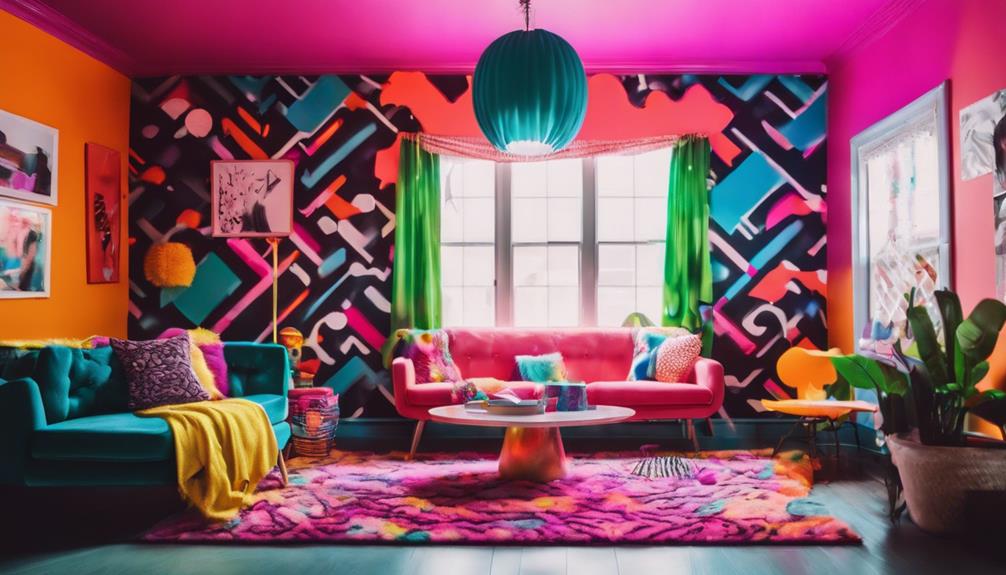
Adding a touch of playfulness to home decor can breathe life and personality into living spaces. From whimsical ruffles to pop art-inspired graphic designs, incorporating playful touches can create a vibrant and contemporary atmosphere. Playful decor elements like quirky patterns and unconventional textures bring a sense of joy and individuality to interiors, allowing for self-expression and creativity to shine through. Here is a snapshot of how these elements can be integrated into home decor:
| Playful Touches | Description | Example |
|---|---|---|
| Ruffles | Whimsical and flirty | Ruffled cushions or curtains |
| Pop art-inspired | Contemporary and vibrant | Floral patterns or candy cane stripes |
| Quirky elements | Unconventional and fun | Unique textures or bold color choices |
Seventies Nostalgia in Home Design
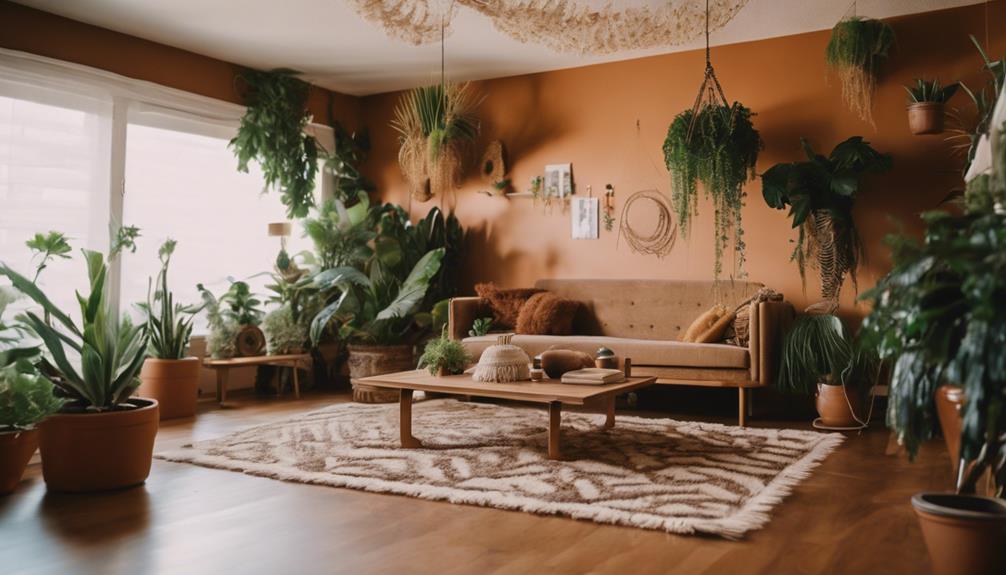
Embracing the essence of seventies nostalgia in home design brings forth a revival of retro-inspired interiors and a palette of saturated colors. Dark maximalism, a key trend within this style, sets the mood with rich textures and deep hues, creating cozy yet dramatic spaces.
Sunset shades play a significant role in infusing comfort and joy into living areas, perfectly aligning with the seventies revival theme. Rattan furniture, a timeless choice, adds a touch of sustainability and versatility to both classic and modern interiors, capturing the essence of the seventies era.
To enhance the retro vibe, unusual angles, rounded shapes, and tactile fabrics are incorporated, bringing character and a sense of nostalgia to room design. This blend of elements from the past results in unique and inviting spaces that celebrate the charm and creativity of seventies design trends.
Updated Color Palettes
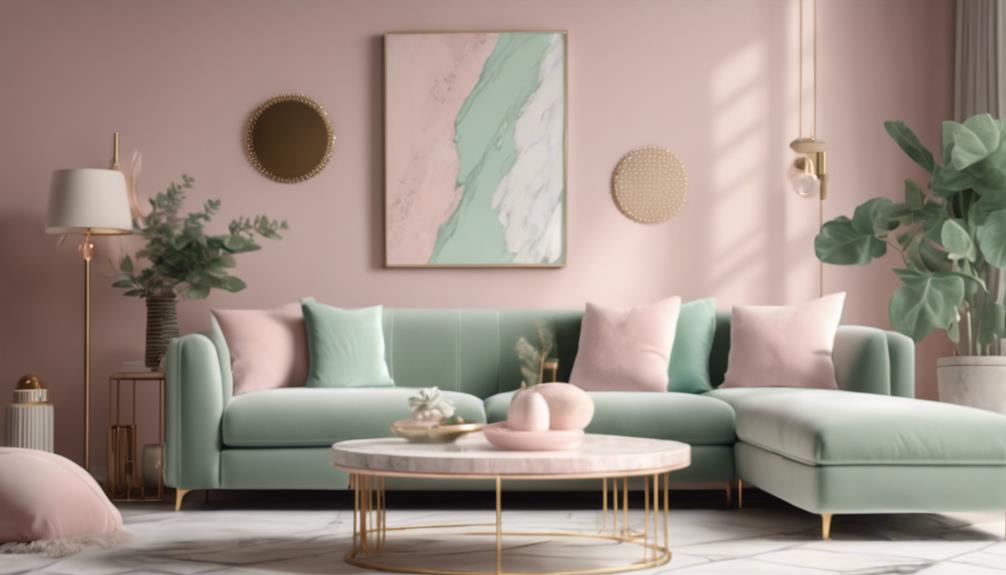
Incorporating warm neutrals and earthy hues into contemporary color palettes creates a harmonious and inviting atmosphere in interior design. Color trends are leaning towards earthly colors like cozy browns, pale pinks, and soft yellows to infuse spaces with warmth and coziness.
These modern aesthetics often feature warm undertones that tie the palette together for a cohesive look. In today's interior design, contemporary color palettes are dominated by earthy hues such as ochre, tan, taupe, and greys, which bring a calming effect to various rooms.
Additionally, golden tones are making a comeback, with variations like darkened brass and warm metallic shades being embraced for their ability to add balance and sophistication to home decor. By incorporating these updated color palettes, homeowners can achieve a stylish and inviting ambiance in their living spaces.
Sustainable and Eco-Friendly Elements
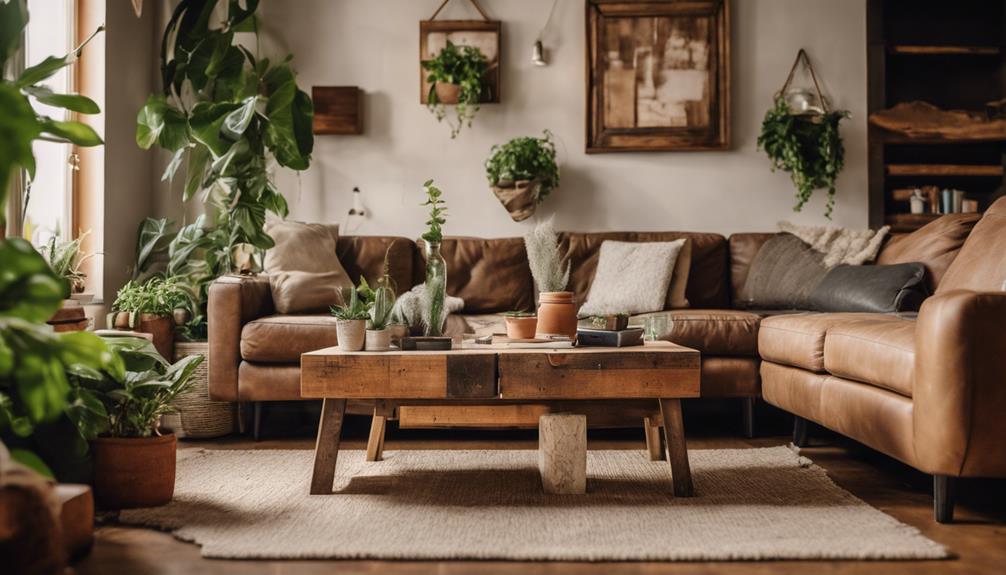
We prioritize sustainability in interior design by utilizing recyclable and renewable materials to reduce environmental impact. Sustainable design focuses on eco-friendly materials such as recycled plastics and reclaimed wood, minimizing waste and promoting a greener lifestyle. Incorporating biophilic design elements like plants and natural light not only enhances well-being but also fosters a deeper connection to nature within living spaces.
In 2024, sustainable choices are at the forefront of eco-friendly trends, with a growing emphasis on supporting local artisans and opting for handcrafted objects. By choosing products made by local craftsmen, we not only reduce the carbon footprint associated with long-distance shipping but also support the local economy. Mindful living is key, as consumers increasingly value the story behind each piece of decor and prioritize environmentally conscious practices. Making use of renewable materials and embracing sustainable design principles can notably reduce the environmental impact of home decor, paving the way for a more eco-friendly future.
Frequently Asked Questions
What Is the Next Big Thing in Home Decor?
The next big thing in home decor is the seamless fusion of traditional charm with contemporary comforts. This trend combines past elegance with modern convenience, creating a fresh and inviting atmosphere in living spaces.
What Is the Decorating Trend for 2024?
Warm neutrals like earthy beiges and off-whites are currently dominating the home decor scene for 2024.
Ruffles are adding a playful touch to cushions and table linens, while pop art-inspired florals and candy cane stripes bring a modern and vibrant aesthetic.
The one-wall kitchen design is popular for its space-saving solutions, and window seats are in demand for their extra seating options and concealed storage benefits.
What Is the Current Decorating Style?
The current decorating style emphasizes a fusion of traditional and contemporary design elements for a fresh appeal. Designers are incorporating vintage finds and personalized decor to add warmth and character to modern interiors.
Traditional elements are being reimagined with a modern twist to create timeless and comfortable living spaces. Smart living is a key trend, merging past charm with future comforts in interior decor.
Homeowners are prioritizing how spaces make them feel, focusing on various light sources for layered lighting and ambiance.
Is Brown Furniture Coming Back in 2024?
Yes, brown furniture is indeed making a comeback in 2024. As warmer, earthy tones replace cooler grays and whites, designers are incorporating brown furniture to create a cozy and inviting atmosphere in modern interiors.
This resurgence adds a timeless and sophisticated look, blending nostalgia and elegance with contemporary design trends. The trend reflects a shift towards more natural and sustainable design choices this year.
Conclusion
To sum up, the new trend in home decor is all about sleek sculptural furniture, warm neutrals, and playful touches.
With a nod to seventies nostalgia and updated color palettes, homes are now showcasing innovative design solutions and eco-friendly elements.
Imagine walking into a room filled with unique lighting fixtures, cozy textures, and sustainable materials – that's the new look of modern home decor.
Stay ahead of the curve and transform your space with these exciting trends.
Interior
Can Interior Design Help Beat the Heat
Seeking relief from the heat? Discover how interior design strategies can transform your space into a cool oasis.
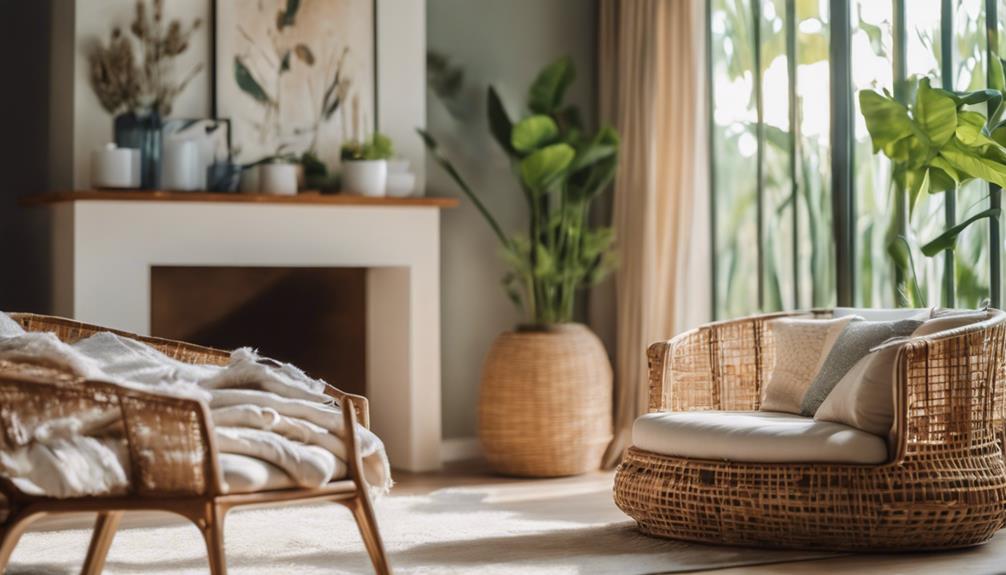
When battling the heat, interior design can be your ally! Incorporate shading elements like awnings and umbrellas for relief from the sun. Opt for light-colored fabrics such as cotton or linen to reflect heat and create a rejuvenating feel. Boost air circulation with ceiling fans and place them strategically for maximum cooling. Create outdoor cooling areas with shade options, water features, and cooling fabrics. Harness natural shade by planting trees strategically. Design cooler indoor spaces with light colors, natural elements, and the use of water features. Implement cool color schemes for a calming effect and enhanced comfort. Discover how to beat the heat with clever interior design!
Key Takeaways
- Incorporate light-colored fabrics and cooling elements to reduce heat indoors.
- Use air circulation tools like fans strategically for improved indoor cooling.
- Design outdoor spaces with shade options and cooling fabrics for comfort.
- Utilize natural shade from trees to cool indoor environments effectively.
- Implement cool color schemes and water features for a refreshing indoor ambiance.
Utilizing Shading Elements for Cooling
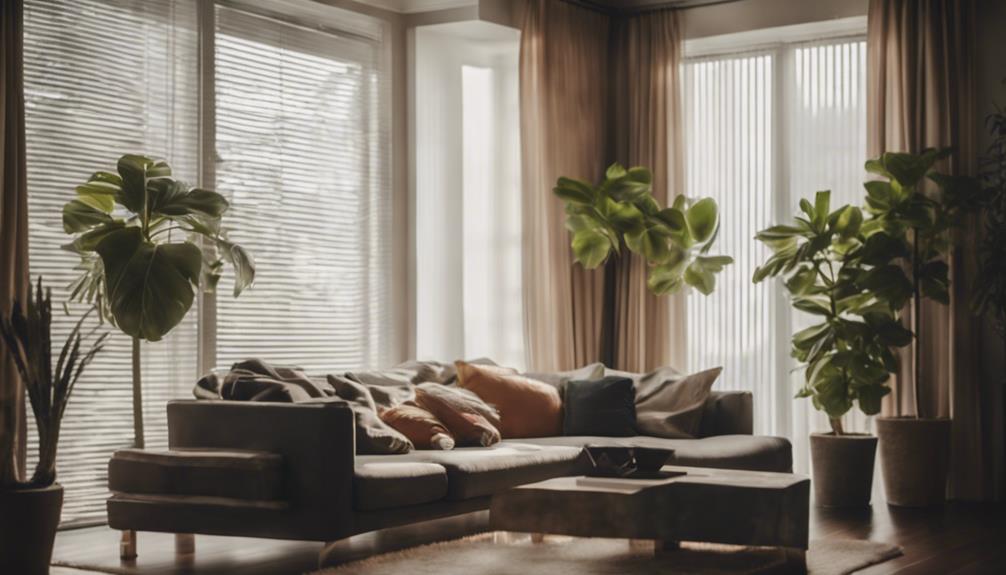
When designing for cooling, consider utilizing shading elements such as awnings or umbrellas to effectively reduce heat in outdoor spaces. These shading elements not only provide relief from the sun but also add a stylish touch to your outdoor area. By incorporating awnings or umbrellas, you create shaded spots where you can relax without worrying about the scorching heat. This simple addition can make a significant difference in how comfortable your outdoor space feels during hot days.
Shading elements like awnings also help protect your outdoor furniture from sun damage. They act as a barrier, preventing direct sunlight from fading or deteriorating your furnishings. Additionally, these elements contribute to the overall aesthetic appeal of your outdoor space, enhancing its visual appeal while keeping it cool and enjoyable.
Incorporating Light-Colored Fabrics
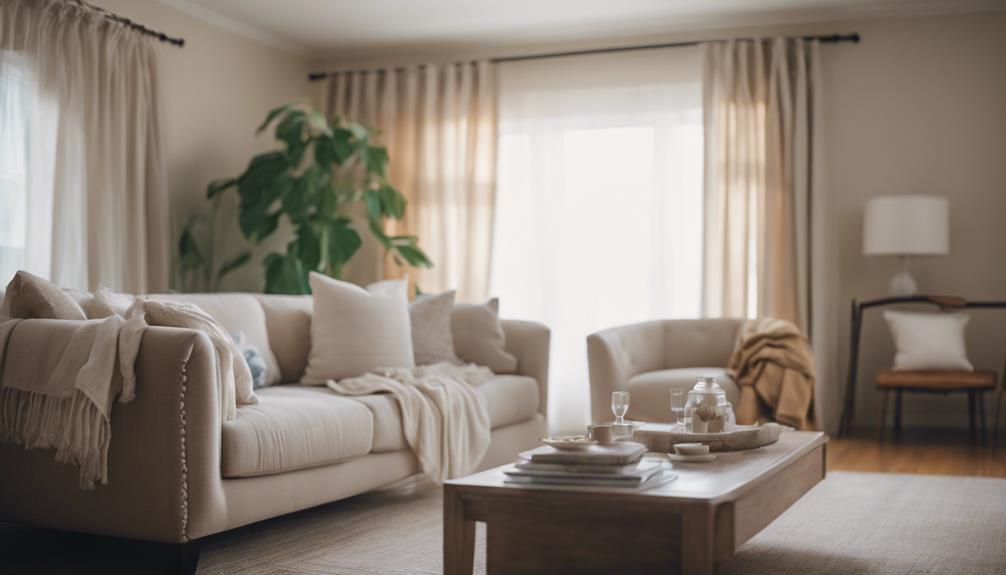
Consider enhancing the cooling effect in your outdoor space by incorporating light-colored fabrics that reflect heat and create a more invigorating environment. In hot climates, choosing light-colored fabrics for your outdoor furniture, cushions, and decor can make a significant difference in how you experience your outdoor space. Light-colored fabrics like cotton or linen not only look stylish but also help to keep the area cooler by reflecting the sun's rays instead of absorbing them. Opting for UV-resistant and heat-reflective fabrics can further amplify this cooling effect, providing a revitalizing oasis on your patio or outdoor lounge. By selecting the right materials and colors, you can transform your outdoor area into a more pleasant and enjoyable retreat during the warm weather.
| Light-Colored Fabrics | Benefits | Example |
|---|---|---|
| Cotton or Linen | Enhance comfort | Light-colored cushions |
| UV-resistant fabrics | Reduce heat retention | Heat-reflective umbrella |
| Heat-reflective fabrics | Provide a cooling effect | Light-colored awnings |
Enhancing Air Circulation With Fans
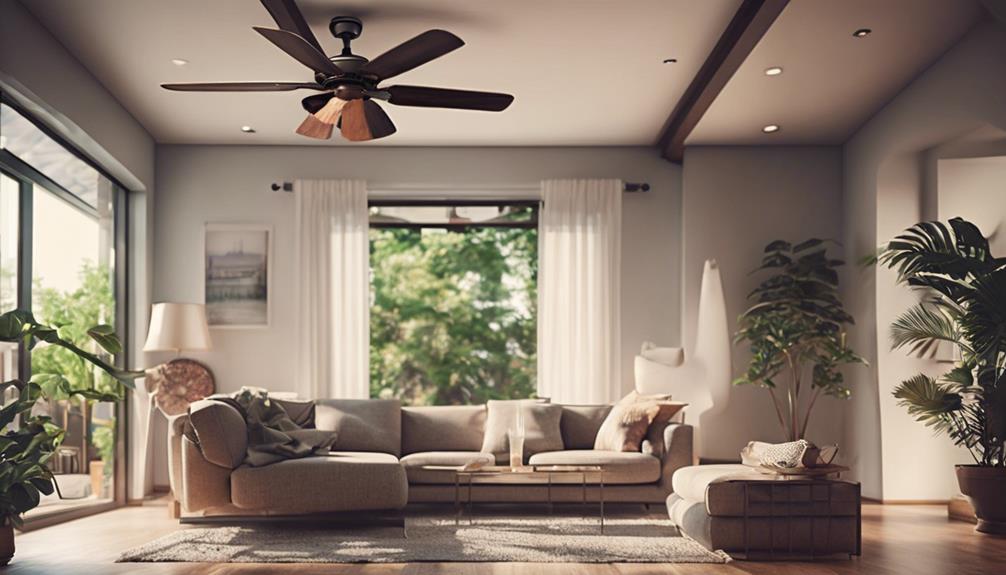
To improve air circulation and enhance cooling in your indoor spaces, consider installing a ceiling fan as a cost-effective solution. Ceiling fans can help create a breeze that makes you feel cooler by circulating the air in the room. Here are three tips to make the most of your ceiling fan for better air circulation and a more comfortable environment:
- Combine with Standing Fans: Using standing fans in conjunction with your ceiling fan can boost overall air movement, helping to distribute cool air more effectively throughout the room.
- Maximize Placement: Proper placement of your ceiling fan is key to maximizing its cooling benefits. Make sure it's positioned in the center of the room and at the right height to ensure the best airflow.
- Adjust Settings: Experiment with different fan speeds to find the setting that provides the best balance of air circulation and comfort. In hot weather, a higher speed can help create an invigorating breeze, while lower speeds can maintain a gentle circulation of cool air.
Creating Outdoor Cooling Spaces
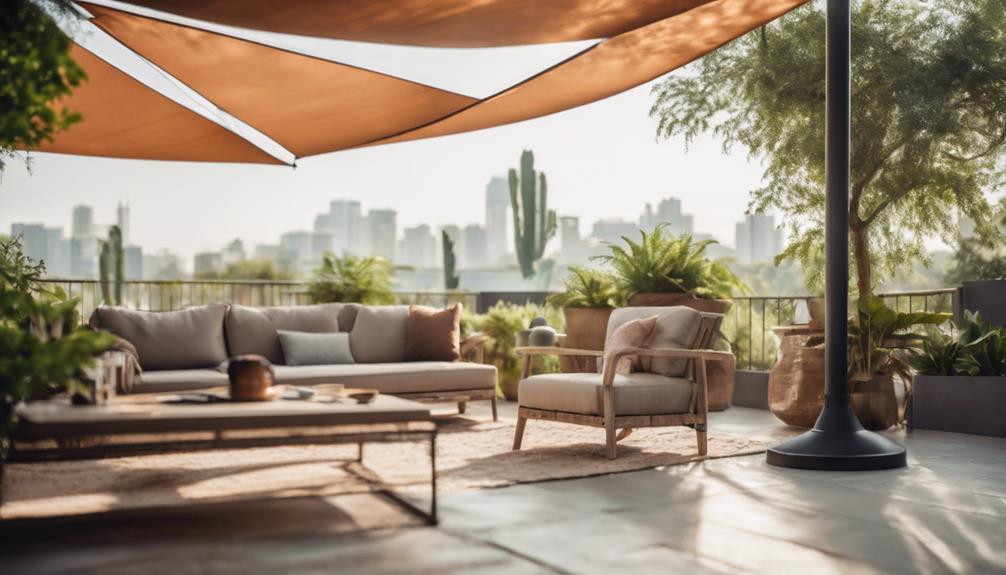
Looking to beat the heat outdoors? Consider adding shade options like pergolas or shade sails to block harmful UV rays and create a cool retreat.
Enhance the ambiance with outdoor water features such as fountains, which not only add a touch of tranquility but also cool the air through evaporation.
Opt for cooling fabrics in your outdoor lounging areas to promote airflow and keep you comfortable during those scorching days.
Shade Options
Create a relaxing outdoor retreat by incorporating shade options like awnings or umbrellas to keep your space cool and protected from the sun. When setting up your outdoor cooling oasis, consider the following:
- Awnings: These can be attached to your home or freestanding, providing versatile shade solutions that block the sun and reduce heat absorption into your outdoor space.
- Umbrellas: Portable and adjustable, umbrellas offer flexibility in shading different areas of your outdoor retreat, allowing you to move them as the sun's position changes throughout the day.
- Outdoor Fans: Installing outdoor fans can help circulate air effectively, creating a gentle breeze that enhances comfort and keeps you cool during hot weather.
Water Features
Enhancing your outdoor space with water features can greatly contribute to creating a cool and relaxing oasis during hot weather. Installing a swimming pool or incorporating water elements like fountains or ponds can help you stay cool and comfortable outdoors. These water features not only add value to your property but also enhance the overall outdoor living experience.
Consult professionals for guaranteeing safe installation to maintain functionality and aesthetic appeal. Water features play a significant role in passive cooling, as they can lower the ambient temperature and improve comfort in your outdoor areas.
Additionally, the visual and auditory appeal of water features, such as the sound of flowing water, can make your outdoor spaces more inviting and enjoyable for relaxation and entertainment.
Cooling Fabrics
To maintain a cool and inviting outdoor atmosphere, consider incorporating cooling fabrics into your outdoor space design. Here are three tips to help you create a rejuvenating outdoor oasis:
- Light-colored fabrics like cotton and linen: Opt for light-colored fabrics to reflect heat and keep your outdoor space cooler.
- Materials that feel cool to the touch: Choose materials like bamboo or silk that feel cool to the touch, enhancing comfort in your outdoor areas.
- Heat-reflective fabrics: Select heat-reflective fabrics for outdoor furniture and curtains to contribute to a more comfortable environment.
Harnessing Natural Shade With Trees
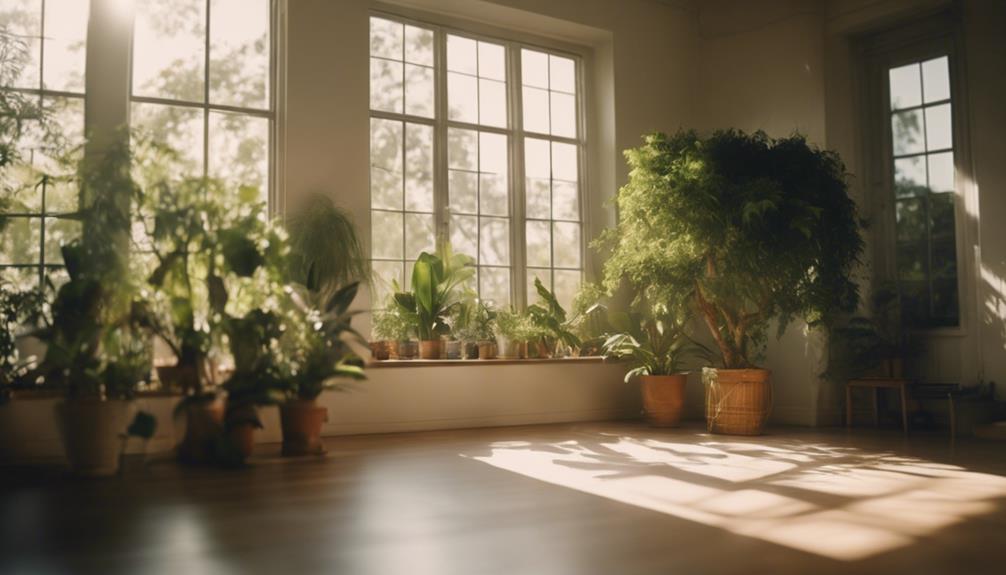
When it comes to cooling your home naturally, strategic tree placement is vital.
Choosing the right tree species, like deciduous ones, can offer shade in the summer and sunlight in the winter.
Remember that proper tree maintenance is essential for keeping your shaded oasis healthy and thriving.
Tree Positioning for Shade
Strategically positioning trees around your home can effectively harness natural shade to reduce indoor heat gain. Here are three key tips for maximizing the shade provided by trees:
- Deciduous Trees: Opt for deciduous trees when planning your landscaping. These trees offer shade during the hot summer months while allowing sunlight to filter through in the winter, helping to naturally regulate indoor temperatures.
- East and West Placement: Place trees strategically on the east and west sides of your home. Trees on the east side can block the morning sun, while those on the west side can provide shade from the intense afternoon heat.
- Window Coverage: Plant trees near windows to prevent direct sunlight from entering and heating up your home. This not only helps in cooling your interior but also adds to the overall beauty of your property.
Tree Species Selection
Selecting the appropriate tree species plays a crucial role in effectively harnessing natural shade to cool your home during hot seasons. Deciduous trees like Maple or Oak are excellent choices as they provide shade in the summer when their leaves are full but allow natural light to filter through during the cooler months when they shed. On the other hand, evergreen trees like Pine or Cedar offer continuous shade and protection from the sun's rays throughout the year. Strategic planting of trees around your home can greatly reduce indoor temperatures by up to 20 degrees Fahrenheit. Consider placing trees on the south and west sides of your house to block the sun's strongest rays in the afternoon, helping to minimize heat gain indoors.
| Deciduous Trees | Evergreen Trees |
|---|---|
| Maple | Pine |
| Oak | Cedar |
Maintenance for Healthy Trees
To maintain healthy trees for ideal shade coverage, regular pruning and trimming are essential. Here are three key maintenance practices to make sure your trees are thriving and providing excellent shade:
- Proper Watering and Fertilizing: Maintaining a consistent watering schedule and providing the right nutrients through fertilization are important for tree health and sustained shade provision.
- Pest and Disease Monitoring: Regularly check your trees for signs of pests and diseases to prevent damage and guarantee continuous shade benefits.
- Mulching: Applying mulch around the base of trees helps retain moisture, regulate soil temperature, and promote tree vitality, contributing to better shade coverage.
Designing for Cooler Indoor Environments
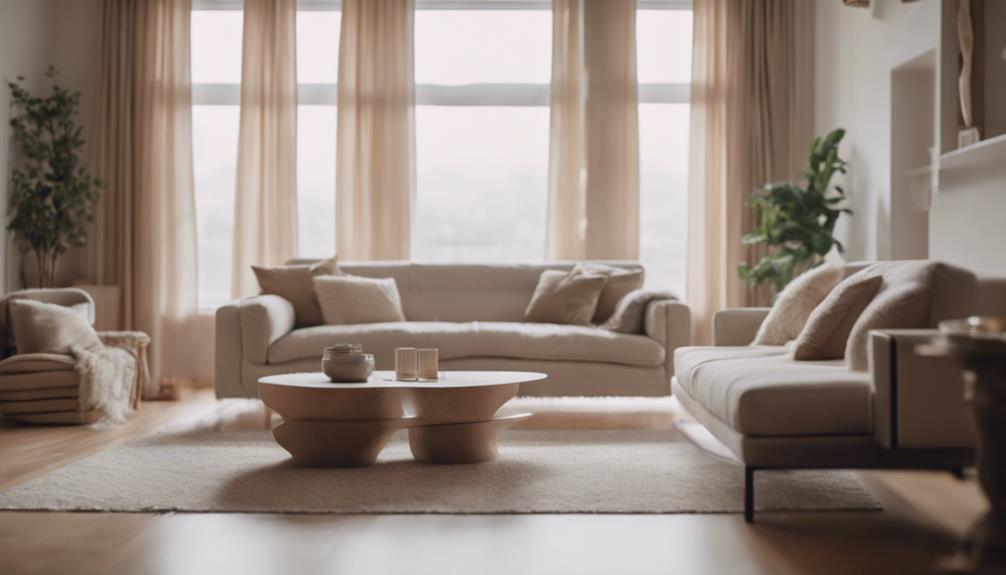
When designing for cooler indoor environments, consider incorporating light and airy color schemes like pastel blues and soft greens to help reflect sunlight and maintain a comfortable temperature. Adding natural elements such as indoor plants and wooden accents can also aid in cooling interiors and creating an invigorating ambiance.
To maximize airflow and ventilation, utilize ceiling fans and open windows during cooler times to help regulate indoor temperatures effectively. Avoiding heat-generating appliances and opting for cooling materials like cotton and linen for bedding can further enhance comfort during hot weather.
Maximizing Cooling Effects of Water Features
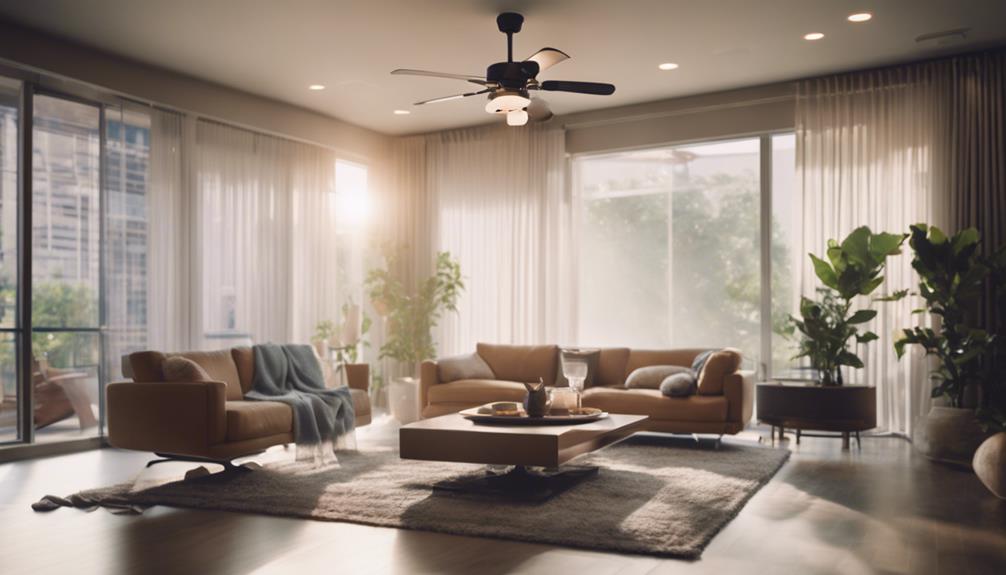
Consider incorporating water features like fountains and ponds to maximize the cooling effects in your outdoor space. Water features can notably lower ambient temperatures by utilizing evaporative cooling, where the evaporation from water surfaces absorbs heat, creating a revitalizing atmosphere.
Here are three ways to enhance the cooling effect of water features:
- Strategic Placement: Position water features strategically in your outdoor space to optimize the cooling effect. Placing fountains or ponds in areas where they can catch the breeze will help circulate the cool air they produce.
- Proper Maintenance: Regularly maintain your water features to make sure they function efficiently. Clean the water surfaces to promote better evaporation and consider adding aquatic plants to enhance the cooling effect.
- Size Matters: The size of your water feature can impact its cooling capabilities. Larger water features tend to have a greater cooling effect as they provide more surface area for evaporation, effectively reducing the surrounding temperatures.
Implementing Cool Color Schemes
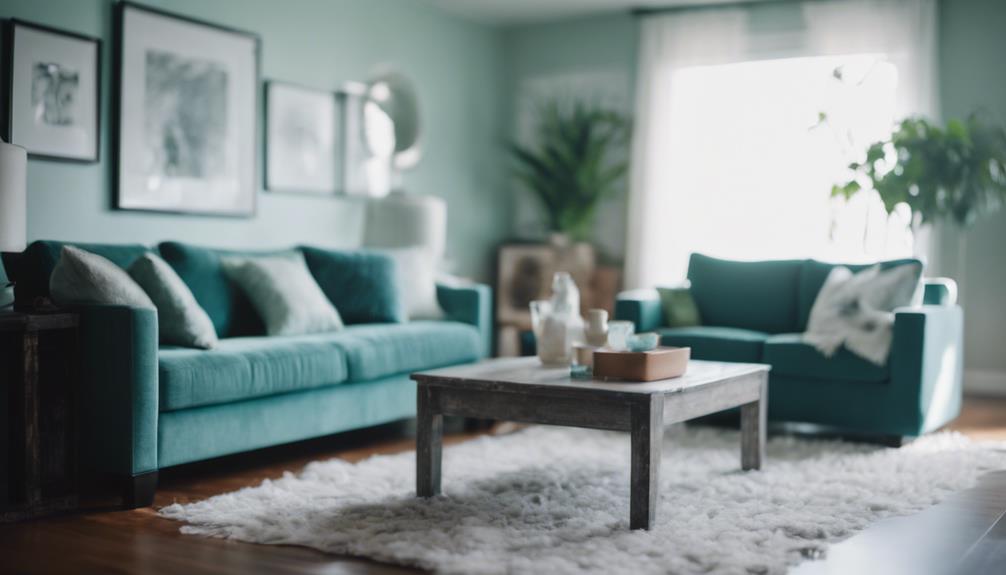
Cool color schemes, such as pastel blues and soft greens, can effectively reflect sunlight to create a soothing atmosphere in your living space. By incorporating light-colored sheer curtains and opting for calming whites, you can enhance this effect and maintain a rejuvenating ambiance indoors. Choosing cool color schemes is not only aesthetically pleasing but also a practical way to combat heat waves and keep your home cool during hot weather.
To emphasize the benefits of implementing cool color schemes, let's take a look at the following table:
| Cool Color Scheme Benefits |
|---|
| Reflect sunlight effectively |
| Create a soothing atmosphere |
| Aid in maintaining cooler interiors |
| Enhance the rejuvenating ambiance |
Balancing Aesthetics and Temperature Control
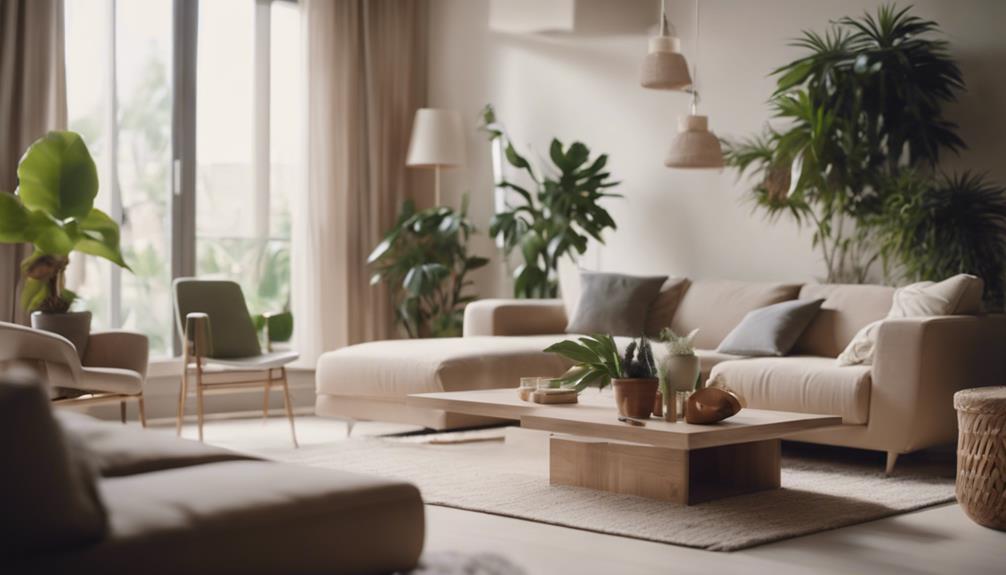
To maintain both a stylish look and comfortable temperature in your living space, it's important to strike a balance between aesthetics and effective temperature control strategies. Here are some tips to help you achieve this balance:
- Optimizing Airflow: Positioning furniture to allow for better air circulation and using fans strategically can help cool down your space without sacrificing style. Enhancing airflow prevents stagnant hot air pockets from forming, keeping your room breezy and pleasant.
- Choosing Cooling Materials: Selecting fabrics like cotton, linen, and bamboo for upholstery and curtains can aid in temperature control. These materials aren't only stylish but also breathable, allowing for better heat dissipation and creating a cooler atmosphere in your home.
- Light-Colored Aesthetics: Light and airy color schemes can visually expand your space while reflecting sunlight to keep temperatures lower. Embracing light-colored walls, furniture, and decor can help maintain a sense of coolness and brightness in your interior design.
Frequently Asked Questions
What Is the Biggest Problem in Interior Designing?
In interior design, addressing these challenges is essential for creating comfortable and sustainable living environments. The biggest problem often revolves around poor insulation and inefficient building designs. These issues lead to increased reliance on air conditioning systems, driving up energy costs and impacting comfort levels. Without proper ventilation and shading, indoor spaces struggle to maintain ideal temperatures.
Overuse of glass in architecture can also contribute to heat gain problems. Tackling these challenges is vital for creating comfortable and sustainable living environments.
What Problems Does Interior Design Solve?
Interior design solves various issues, enhancing comfort and functionality. It optimizes space, improves aesthetics, and boosts mood.
By incorporating natural elements, strategic layouts, and cooling materials, interior design combats heat waves and creates a rejuvenating environment. Efficient use of colors, furniture placement, and ventilation techniques contribute to cooler interiors.
Choosing the right design elements helps maintain a comfortable atmosphere, making your space a cozy retreat from the heat.
What Are the Disadvantages of Interior Design?
When considering the disadvantages of interior design, it's crucial to weigh the costs, potential disruptions, and upkeep involved. Expenses for furniture, decor, and professional services can add up quickly. Renovations may require temporary relocation and disrupt your routine. Trends can become outdated, leading to frequent updates. Changing tastes may leave you dissatisfied with previous choices. Maintaining intricate designs can be time-consuming.
These factors highlight the challenges of interior design beyond just the aesthetic appeal.
How Does Interior Design Help People?
Interior design plays a vital role in shaping how people experience and interact with their surroundings. By incorporating elements like color, furniture, and decor, interior design enhances comfort and functionality in homes and workplaces. It can improve mood, productivity, and overall well-being by creating visually appealing and organized environments.
Whether it's through maximizing space, implementing ergonomic solutions, or enhancing aesthetics, interior design plays an essential role in shaping how people experience and interact with their surroundings.
Conclusion
Now that you've learned how interior design can help beat the heat, you're ready to transform your space into a cool and revitalizing oasis.
By incorporating shading elements, light-colored fabrics, fans, outdoor cooling spaces, trees, water features, and cool color schemes, you can create a comfortable environment even on the hottest days.
So go ahead, get creative with your design choices and stay cool all summer long!
Home Decor
Where Can I Find Unique Home Decor
Yearning for exclusive home decor finds? The answer lies in unexpected places, offering a touch of elegance and individuality – discover more below!
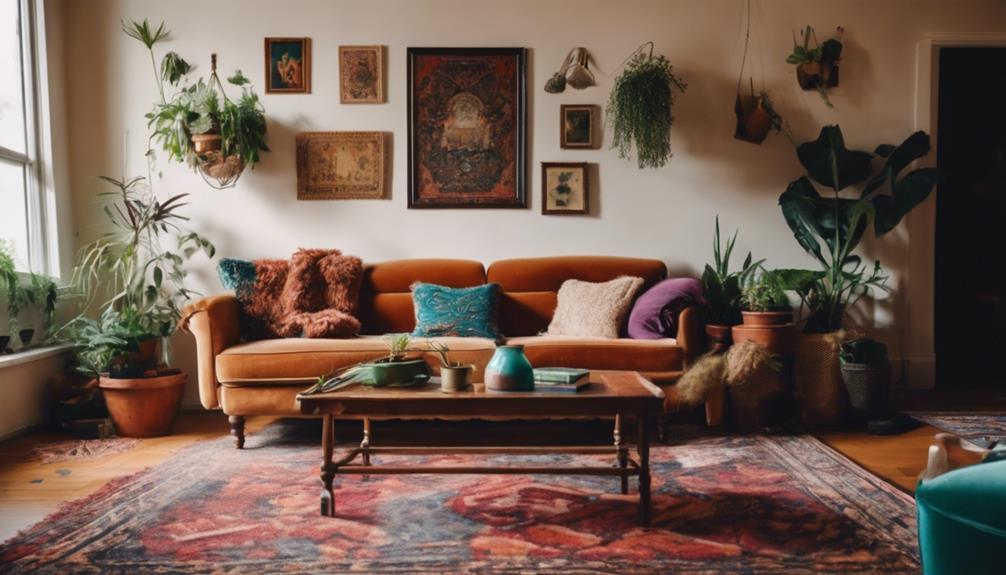
When on the hunt for unique home decor, check out specialty stores for a carefully chosen selection of elegant items like glass vases and metal wall art. Explore online marketplaces such as Etsy, where independent artisans create one-of-a-kind pieces. Artisan markets offer handcrafted treasures with cultural flair, while boutique shops provide personalized service and support local designers. Olive & Cocoa presents a variety of distinctive decor options praised for quality and craftsmanship. Uncover a world of creativity and charm in these spots to elevate your living spaces with style and personality. More insights await for those seeking exclusive decor touches.
Key Takeaways
- Explore specialty home decor stores for curated and exclusive items.
- Browse online marketplaces like Etsy for unique artisanal pieces.
- Visit artisan markets for handcrafted decor with cultural significance.
- Shop at boutique shops for personalized and charming selections.
- Consider Olive & Cocoa for high-quality, unique decor options and stylish pieces.
Specialty Home Decor Stores
When we visit specialty home decor stores like Olive & Cocoa, we encounter a thoughtfully curated selection of unique and high-quality items for our homes. These stores offer a diverse range of home decor treasures, including elegant glass vases, intricate metal wall art, and stunning wall mirrors that can elevate the aesthetic of any room.
One standout item often found in these stores is the Watercolour Birth framed jewelry, a personalized piece that adds a sentimental touch to our living spaces. The variety of styles and influences in these stores allow us to explore different design aesthetics and find pieces that truly speak to our individuality.
Whether we're looking for a statement wall art or a delicate glass ornament, specialty home decor stores provide us with exclusive and one-of-a-kind options to express our creativity and style within our homes.
Online Marketplaces
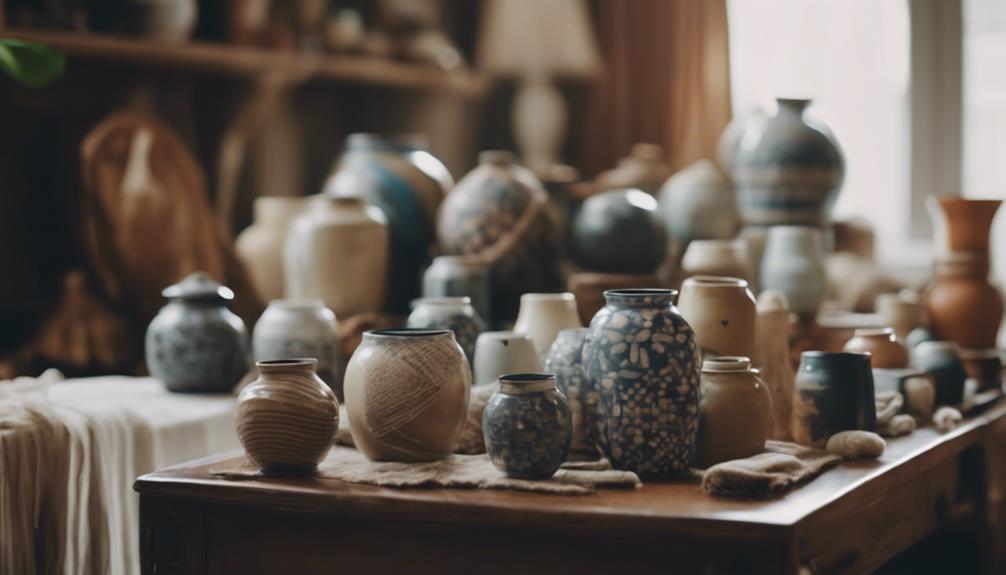
Exploring beyond specialty home decor stores like Olive & Cocoa, online marketplaces such as Etsy offer a vast array of unique home decor items crafted by independent artisans. These platforms are a treasure trove for those seeking handmade and personalized gifts, including quirky wall art that adds character to any space. One of the perks of shopping on Etsy is the opportunity to support small businesses and connect directly with the creators of these distinctive pieces.
Here is a glimpse of what you can find on Etsy:
| Etsy Seller | Unique Home Decor |
|---|---|
| Handmade | Quirky Wall Art |
| Personalized Gifts | Independent Artisans |
Etsy provides a platform for independent artisans to showcase their creativity, offering shoppers a wide selection of unique home decor items that you won't typically find in mainstream stores. Whether you're looking for unconventional wall art or specialized home accents, Etsy is a go-to destination for adding a touch of individuality to your living space.
Artisan Markets
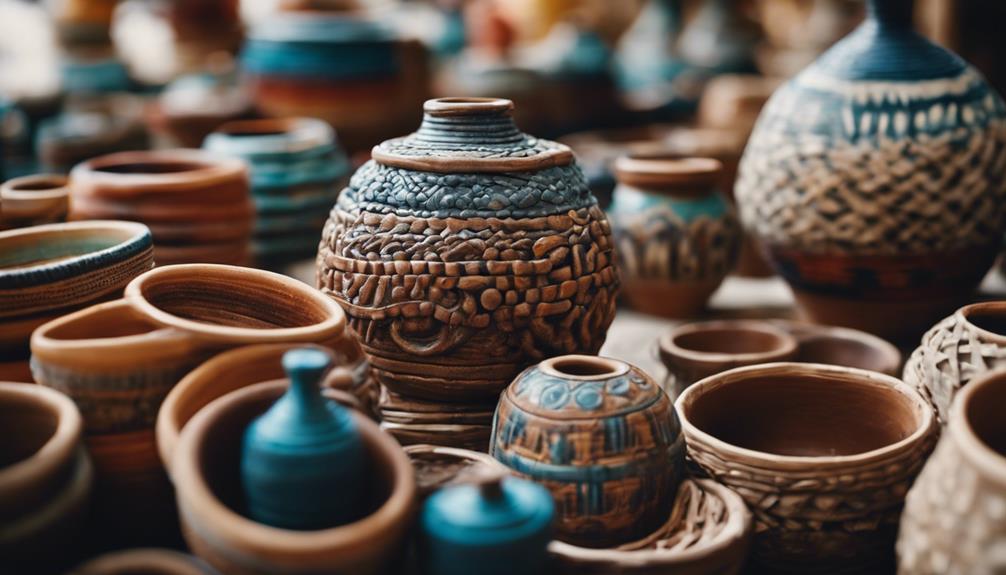
Artisan markets offer a diverse selection of handcrafted home decor pieces created by skilled artisans. These markets are a treasure trove of unique items that add a touch of personality to any living space. From intricately designed art pieces to stunning glassware and cozy textiles, artisan markets showcase a wide range of handcrafted products that you won't find in mainstream stores. By supporting local craftsmen, these markets not only help preserve traditional crafting techniques but also promote community sustainability.
One of the most exciting aspects of shopping at artisan markets is the opportunity to discover home decor treasures with cultural significance. Each item tells a story and carries a piece of the artisan's heritage, making it a special addition to your home. Whether you're looking for a statement piece for your living room or a thoughtful gift for a loved one, artisan markets offer a rich tapestry of craftsmanship and creativity.
Boutique Shops

In our search for unique home decor, boutique shops offer a curated selection of handcrafted and artisanal pieces that add character and charm to any living space. These specialized stores go beyond the ordinary, showcasing items that aren't commonly found in mainstream retail outlets.
At boutique shops, customers can expect personalized service, creating a one-of-a-kind shopping experience that caters to their individual tastes and preferences. One of the key highlights of boutique home decor stores is their focus on supporting independent designers and small businesses.
By sourcing products from these creative minds, boutique shops contribute to the local and handmade movement, fostering a sense of community and uniqueness in every piece they offer. Shopping at boutique home decor stores allows individuals to express their personal style and creativity through distinctive items that reflect their personality and values.
Embrace the charm and individuality that boutique shops bring to the world of home decor.
Unique Home Decor Ideas
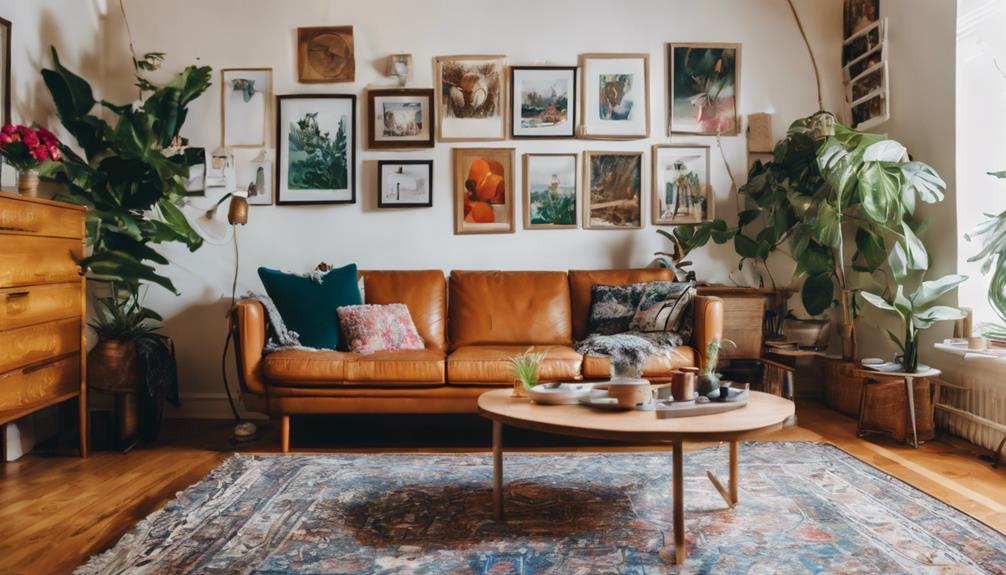
Perusing various sources can inspire fresh and innovative ideas for unique home decor. When looking for unique home decor ideas, consider Olive & Cocoa for a wide range of options.
From personalized pillows to bird baths, Olive & Cocoa offers a variety of items to spruce up your living space. Customers rave about the excellent quality, craftsmanship, and durability of their products, making them a reliable choice for adding a touch of elegance to your home.
Additionally, Olive & Cocoa is known for its impeccable packaging and presentation of gifts, making them perfect for special occasions. Whether you're searching for custom wall decor or modern living accents, Olive & Cocoa has something for everyone.
Their Decor Bird collection and stylish Black Script pieces are particularly popular among those seeking a chic and unique aesthetic. Trust Olive & Cocoa to provide you with exceptional service and one-of-a-kind finds to elevate your home decor.
Frequently Asked Questions
What Is the Most Sold Home Decor?
The most sold home decor items range from Christmas tree ornaments to Mexican swing hammocks. They include cotton napkins, ceramic ornaments, and wood sculptures.
Curated gift sets are popular, featuring Mexican-themed items like coloring postcards and Day of the Dead decorations. Artisan crafted pieces such as African wood masks, Barro Negro wall decor, and Copal Wood Alebrije deer figurines are in high demand.
Glassware from Murano, known for its craftsmanship, is also a top choice for unique home decor.
How Can I Decorate My House With Little Money?
We can decorate our house with little money by shopping at thrift stores, yard sales, and online marketplaces for affordable decor pieces. Consider DIY projects using inexpensive materials like pallet wood, mason jars, and thrifted items.
Look for budget-friendly decor items at discount stores, clearance sections, and dollar stores. Repurpose and upcycle old furniture or decor items to give them a fresh look without spending much.
Focus on small changes like rearranging furniture, adding plants, and updating accessories for a cost-effective refresh.
How Can I Make My Home Decor Beautiful?
To make our home decor beautiful, we should focus on mixing textures, patterns, and colors for depth and interest.
Incorporating statement pieces like unique art or accent furniture creates focal points in each room.
Experiment with different lighting types—overhead, ambient, and task lighting—to enhance the mood.
Personal touches like family heirlooms or custom artwork reflect our personality.
Combining old and new elements creates a curated, eclectic look showcasing our individual style and creativity.
How Do I Choose the Best Home Decor?
When choosing the best home decor, consider your style and existing decor. Look for unique pieces that reflect your personality and spark conversation.
Pay attention to quality and craftsmanship for durability. Mix and match styles and textures for a visually appealing look.
Make sure new additions complement your home's color scheme. By aligning with your tastes and focusing on statement pieces, you can create a beautiful and personalized space that you'll love.
Conclusion
In our search for unique home decor, we've explored various avenues like specialty stores, online marketplaces, artisan markets, and boutique shops.
Each of these options offers a distinct experience and a treasure trove of one-of-a-kind pieces to elevate your living space.
Just like a skilled artist, we must carefully select the perfect brushstroke to create a masterpiece.
So, let's continue our journey with curiosity and creativity to find the perfect pieces that speak to our individual style and personality.
Home Decor
How to Make an Easter Egg Tree With Decoupaged Eggs
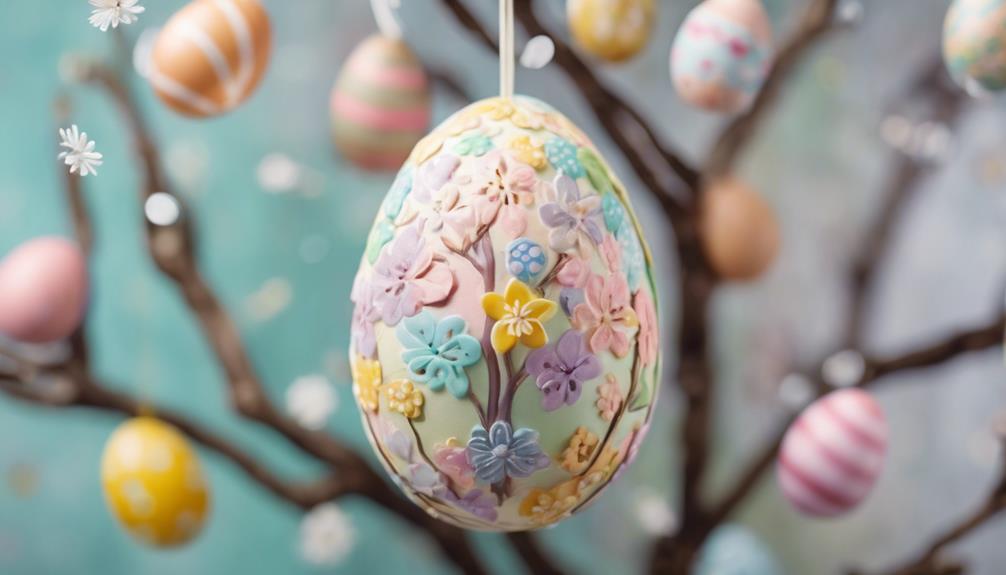
To make an Easter Egg tree with decoupaged eggs, gather craft eggs, decorative napkins, Mod Podge glue, a craft brush, and a floral cone. Prepare eggs by painting them white, selecting napkin designs, and decoupaging them with pastel hues. Arrange eggs on branches in a stable vase, varying heights for visual appeal. Use green paint on twigs for a natural look. Showcase your creation prominently and share on social media. Tips on materials and techniques guarantee success. Master the art of Easter egg trees with detailed steps and expert advice, elevating your festive decor effortlessly.
Key Takeaways
- Paint foam eggs white as a base.
- Select Easter-themed napkins or rice paper for designs.
- Decoupage designs onto eggs with Mod Podge.
- Position eggs on painted twigs in a floral cone.
- Display tree prominently with complementary decorations.
Gather Necessary Supplies
Let's gather all the supplies needed for making our Easter Egg Tree. For the decoupage Easter eggs, we'll need craft eggs, decorative napkins or rice paper, Mod Podge glue, a craft brush, and a floral cone. These items are essential for creating beautifully decorated eggs for our tree. Make sure to have scissors handy to cut the napkins or paper smoothly for the decoupage technique.
In addition to the decoupage supplies, make certain you have all the necessary materials for assembling the egg tree. This includes craft paint for customization, beads for embellishments, wire for hanging the eggs, twigs for a natural touch, and a vase for stability. Having these items ready will make the assembly process smoother and more enjoyable.
Prepare your crafting space with good lighting and a flat surface to work on. Organize your materials in a way that allows easy access while crafting. Clear any clutter or distractions from your workspace to stay focused on creating your Easter egg tree.
Let's get everything together to start this fun and creative project!
Prepare Foam Easter Eggs
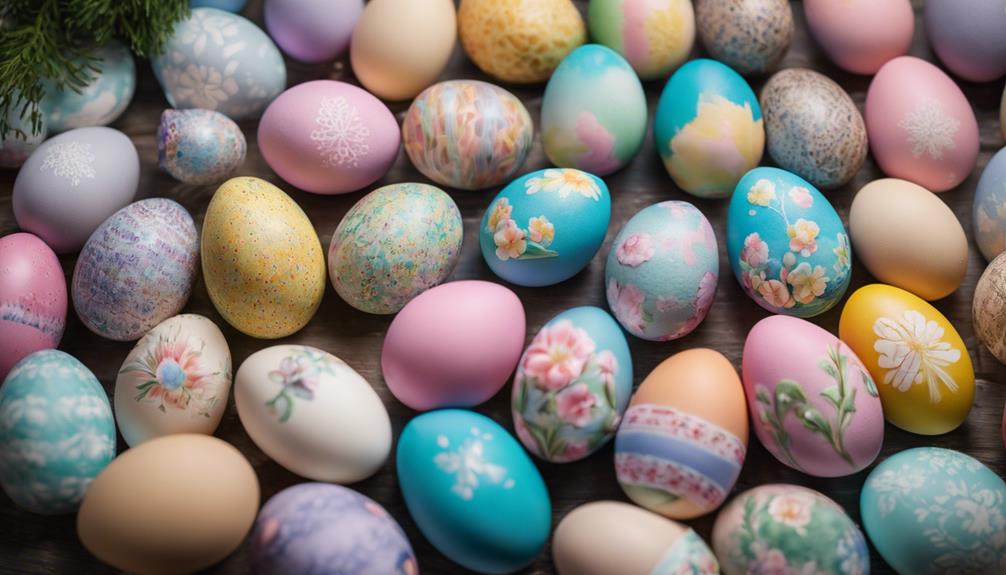
Let's start by painting the foam Easter eggs with white acrylic paint to create a smooth base for the decoupage designs.
Remember to select decorative napkins or rice paper for the decoupage process, ensuring intricate and colorful patterns.
Using Mod Podge or similar decoupage glue will securely attach the cut-out designs onto the foam eggs, resulting in a beautiful Easter decoration.
Egg Painting Techniques
To prepare foam Easter eggs for painting, begin by selecting a shape from decorative napkins to cut out and decoupage onto the eggs using Mod Podge glue. Once the cut-out designs are securely attached, paint the foam eggs with a coat of white acrylic paint. This step creates a clean and uniform base for the subsequent painting process.
After the white paint has dried, apply Mod Podge as a glue to attach the cut-out images firmly to the eggs. To enhance durability and achieve a smooth finish, consider adding additional coats of Mod Podge over the decorated eggs. This protective layer not only secures the designs in place but also guarantees a polished final look.
Decoupage Supplies Needed
Selecting the appropriate supplies is essential when preparing foam Easter eggs for decoupage. Foam Easter eggs, known for their lightweight and smooth surface, provide an ideal base for intricate designs.
To begin, you'll need Mod Podge glue, a versatile adhesive important for securing napkin designs onto the foam eggs. Using a foam brush to apply the Mod Podge glue guarantees an even and smooth application, facilitating the adherence of the decorative napkins.
Cutting out shapes from the napkins allows for precise and customized designs on the foam eggs, enhancing their visual appeal. Additionally, applying a base layer of white acrylic paint on the foam eggs before decoupaging helps the napkin designs stand out vibrantly.
Incorporating these supplies and techniques will enable you to create beautifully decorated foam Easter eggs, perfect for crafting an Easter egg tree that will impress and delight.
Cut Out Napkin Designs

When cutting out napkin designs for the Easter eggs, make sure to choose decorative napkins featuring festive Easter motifs like bunnies, flowers, or eggs. Using sharp scissors, carefully cut out the desired designs from the napkins. It's crucial to cut the designs close to the edges for a clean and precise look on the eggs.
Selecting smaller designs can make cutting and applying them to the egg surface easier. Confirm the cut-out designs are proportional to the size of the eggs for a balanced appearance.
Incorporating these Easter decor elements into your decoupaged eggs can create a charming and seasonal touch to your Easter Egg Tree.
Paint Eggs With White Acrylic
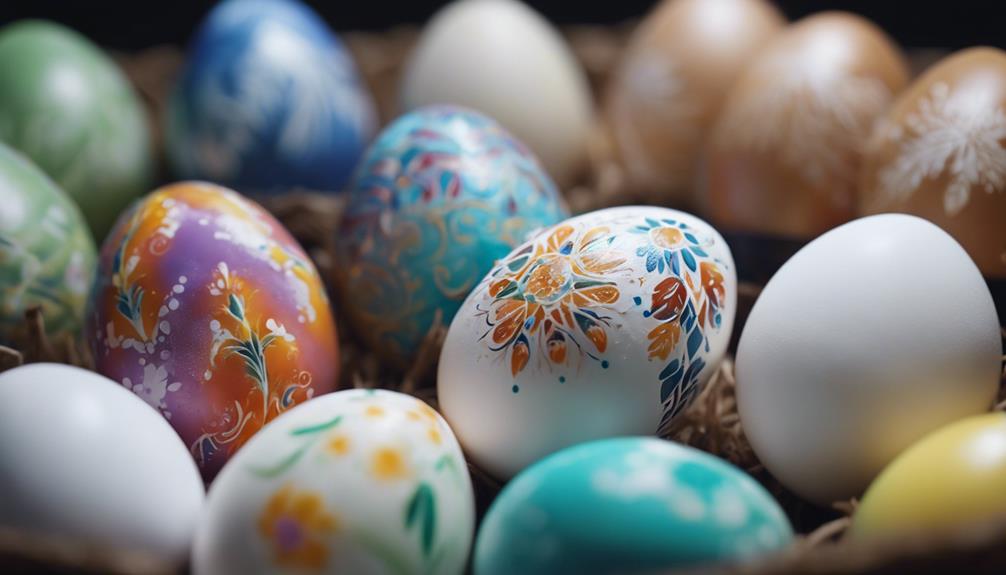
Let's now start preparing the eggs by applying a coat of white acrylic paint for a clean and neutral base. White acrylic paint serves as the foundation for the decoupaged Easter eggs, enhancing the vibrancy of the napkin designs. This step not only guarantees that the colors and patterns of the napkins or rice paper pop but also contributes to a cohesive look for the Easter egg tree. The use of white acrylic paint facilitates better adhesion of the decoupage medium, allowing for a seamless application of the intricate designs onto the eggs. A light coat of white acrylic paint can greatly improve the overall appearance of the eggs, providing a smooth and even surface for the subsequent decoupage process.
| Benefits of White Acrylic Paint |
|---|
| Enhances color vibrancy |
| Ensures cohesive appearance |
| Facilitates adhesion of designs |
Decoupage Napkin Designs
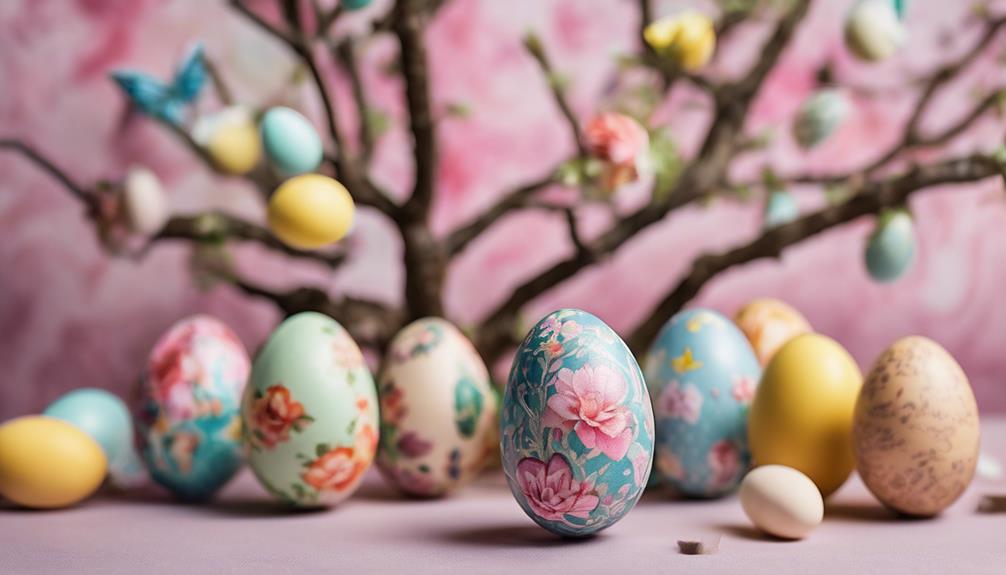
For a vibrant and festive touch to your Easter egg tree, consider selecting napkin designs featuring charming Easter motifs like bunnies, flowers, or eggs.
When choosing napkin designs for your decoupage projects, keep in mind these essential tips:
- Intricate Designs: Opt for napkins with intricate patterns that can be easily cut out and applied to the eggs, adding a detailed and visually appealing look to your Easter decorations.
- Pastel Colors: Select napkin designs in pastel colors to maintain a cohesive and festive theme for your Easter egg tree, creating a soft and welcoming ambiance.
- Secure Attachment: Guarantee the napkin designs are firmly attached to the eggs by using an adequate amount of decoupage glue, preventing peeling or lifting of the designs over time.
- Variety and Interest: Experiment with a variety of napkin designs to introduce diversity and visual interest to your decoupaged eggs, making your Easter egg tree truly unique and eye-catching.
Seal Eggs With Mod Podge
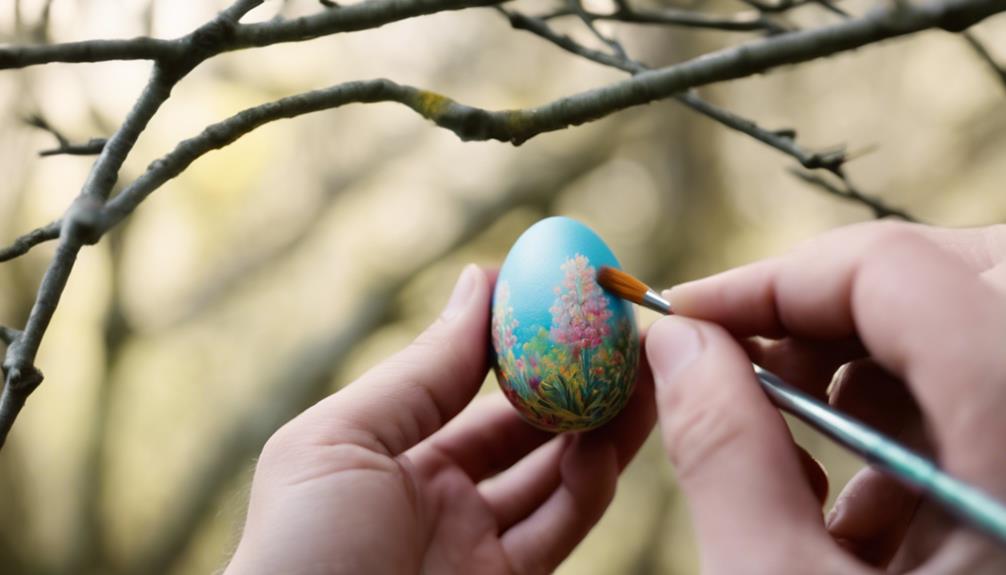
How can we effectively seal decoupaged eggs to protect the designs and enhance their durability?
When it comes to preserving the intricate designs on our decoupaged eggs, using Mod Podge as a sealant is crucial. Mod Podge not only safeguards the colors from fading but also extends the lifespan of the decoupaged eggs. By applying a coat of Mod Podge over the design, we guarantee a smooth and glossy finish, adding a professional touch to our Easter decorations.
One of the advantages of sealing eggs with Mod Podge is its ability to secure the napkin or rice paper design firmly onto the egg surface. This protective layer acts as a barrier against wear and tear, making the eggs more resilient to handling. It's a straightforward and efficient method to maintain the decorative elements intact for an extended period, ensuring that our Easter Egg Tree remains a beautiful centerpiece for years to come.
Assemble Egg Tree
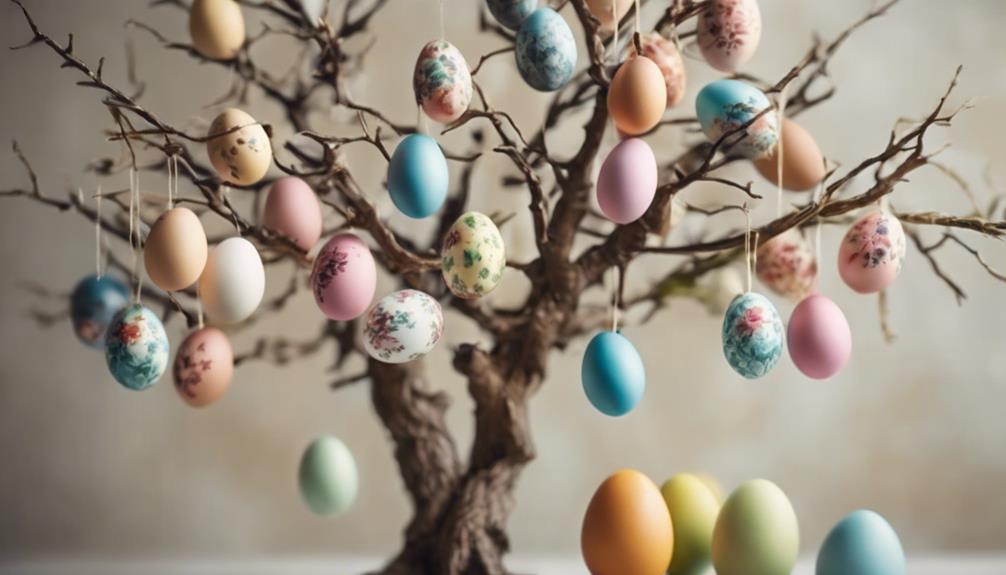
To assemble an Easter egg tree, we need to focus on three key points: the egg tree base, egg placement, and decorating techniques.
First, select a sturdy vase filled with stones to hold the painted twigs securely in place as the base of the tree.
Next, string the decorated eggs onto branches using loops for hanging, ensuring they're evenly distributed for a balanced look.
Egg Tree Base
Let's start by painting twigs with green craft paint to add a vibrant touch to our Easter egg tree base.
Here's how you can assemble your egg tree base decor:
- Painting Twigs: Choose sturdy twigs and apply green craft paint evenly to give them a fresh look, mimicking the essence of spring.
- Arranging in Vase: Once dry, place the painted twigs in a sturdy vase filled with stones for added stability, ensuring your egg tree stands securely.
- Hanging Eggs: Use strings or wire loops to hang the decorated eggs on the branches, creating a delightful visual display that showcases your creativity.
- Decor Variety: To enhance the aesthetic appeal, incorporate a mix of egg colors and designs, making each egg stand out and contribute to the overall charm of your Easter egg tree.
Egg Placement
We carefully position the decorated eggs on the branches of our Easter egg tree, ensuring a balanced and visually pleasing arrangement. By hanging the eggs at varying heights and angles using strings, we create an engaging visual display that captures the essence of the holiday season. It's essential to securely attach the eggs to the branches to prevent any accidental falls, maintaining the integrity of the design.
When assembling the egg tree, consider incorporating a mix of different egg sizes and designs. This variety adds depth and interest to the display, making it more dynamic and eye-catching. By mixing and matching the eggs, you can create a personalized and festive decor piece that reflects your creativity and style.
Once the eggs are in place, step back and assess the overall look of your DIY Easter egg tree. Make any necessary adjustments to achieve the desired aesthetic before showcasing it as a beautiful and unique addition to your holiday decorations.
Decorating Techniques
For assembling the Easter egg tree, start by painting twigs with green craft paint to add a vibrant touch to the decor piece.
Here's how to create your own Easter egg tree at home:
- Paint twigs with green craft paint for a fresh and colorful base.
- Arrange the painted twigs in a vase filled with stones to guarantee stability when assembling the tree.
- Hang the decoupage Easter eggs on the branches using strings to add a festive and personalized element to your home decor.
- Display your DIY Easter egg tree proudly as a beautiful and unique decor piece for the holiday season.
Display Your Creation
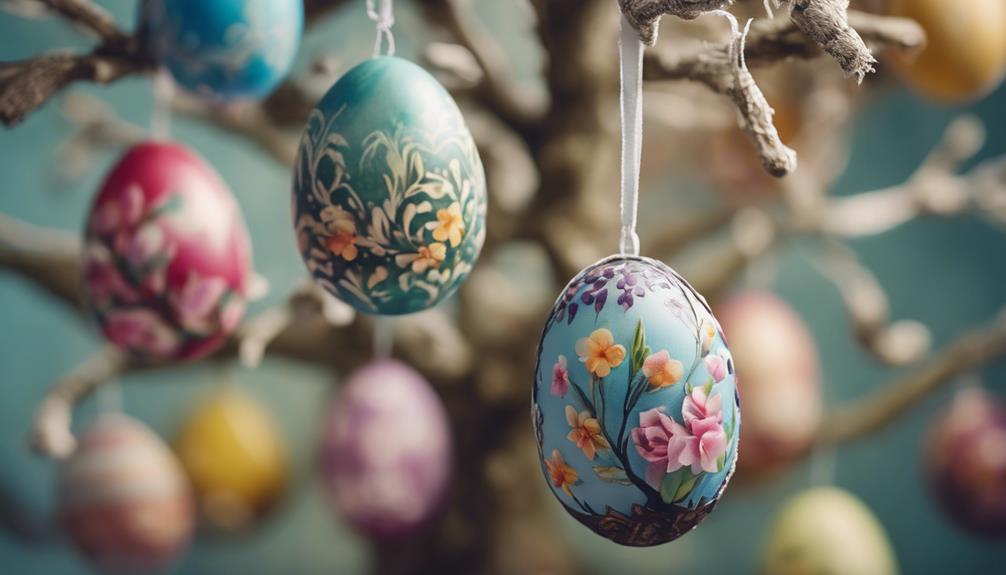
Enhancing the visual impact of your Easter egg tree can be achieved by strategically placing it in a prominent location within your home. Consider showcasing your creation on a mantle, as a table centerpiece, or in the entryway to guarantee maximum visibility and admiration from guests.
To elevate the presentation of your Easter egg tree, utilize a decorative basket or stand that complements the overall design. This not only adds height but also adds a touch of elegance to the display.
In addition to the tree itself, incorporating other Easter decorations around it can create a cohesive and festive atmosphere in your home. By surrounding the tree with complementary elements such as Easter bunnies, pastel-colored ribbons, or spring flowers, you can enhance the overall aesthetic appeal of the display.
Lastly, don't forget to share your Easter egg tree creation on social media or with friends and family. By doing so, you can inspire others to get creative and join in the Easter festivities.
Tips for Success
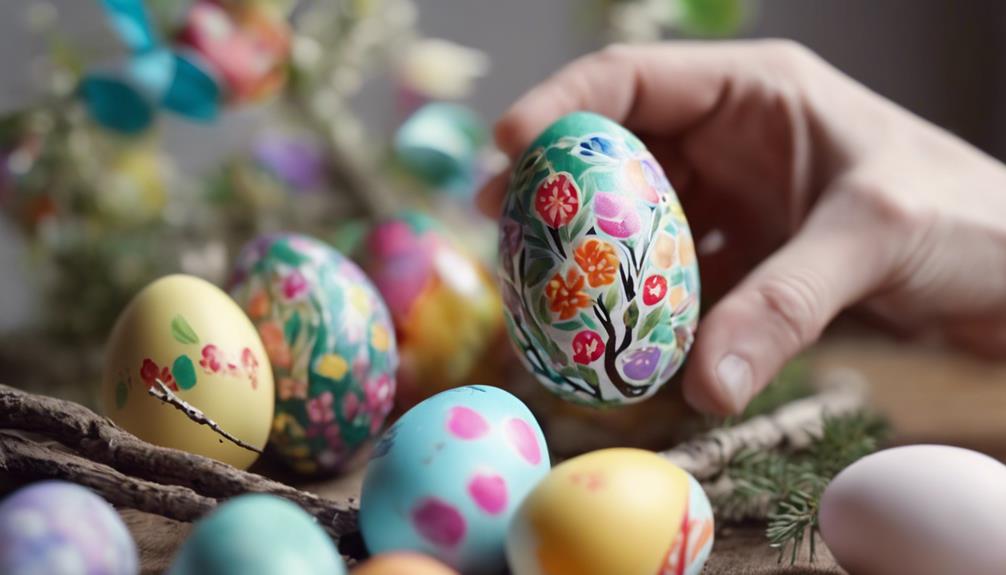
When creating an Easter Egg Tree, it's important to pay attention to material selection, master the decoupage technique, and strategize how to display your tree effectively.
By choosing smaller designs for effortless cutting and secure attachment with decoupage medium, you can avoid wrinkles and lifting issues.
Remember to mix decoupaged and non-decoupaged eggs and vary their angles for a visually engaging and dynamic display.
Material Selection
Selecting the right materials is crucial to creating a vibrant and visually appealing Easter Egg Tree. To guarantee success in this craft project, consider the following materials:
- Foam Easter Eggs: Opt for foam eggs as they're easy to decoupage and hang, providing a lightweight option for your tree.
- Decorative Napkins: Choose napkins with colorful and intricate designs to add a festive and eye-catching element to your eggs.
- Mod Podge Glue: Utilize Mod Podge glue for strong adhesion and to protect the designs on the eggs, ensuring longevity and durability.
- Mix of Finishes: Experiment with a combination of matte and gloss finishes to create visual interest and depth in your Easter Egg Tree.
Remember to apply Mod Podge with a craft brush in a thin layer to achieve smooth and even coverage on the eggs.
These materials will help you create a stunning and unique Easter Egg Tree that will be a delightful addition to your seasonal decor.
Decoupage Technique
Let's explore some essential tips for achieving successful decoupage on Easter eggs.
When using the decoupage technique, opt for delicate rice paper or decorative napkins to adorn your eggs with intricate designs. Apply a thin layer of decoupage medium to the egg surface before carefully placing the chosen design. Smooth out any wrinkles gently using your fingers or a soft brush to guarantee a polished and seamless finish.
To enhance the durability of your decoupage eggs, seal them with multiple coats of decoupage medium. This protective layer not only secures the design but also provides a glossy sheen. Remember to let each coat dry completely before applying the next one to prevent smudges or uneven finishes.
Get creative with your decoupage technique by experimenting with different designs, colors, and finishes. Personalize your Easter eggs by mixing and matching various elements to create a unique and eye-catching display.
With these tips in mind, you can master the art of decoupage and create stunning eggs for your Easter egg tree.
Displaying Your Tree
We recommend positioning your Easter egg tree in a well-lit area to showcase the intricate decoupaged designs beautifully.
When displaying your tree, consider the following tips for success:
- Placement: Choose a prominent spot such as a mantel, side table, or as a centerpiece to make an Easter egg tree the focal point of your decor.
- Variety: Use a mix of egg sizes and designs to add visual interest and depth to your tree, creating an engaging display that can't wait to be admired.
- Decorative Accents: Enhance the overall look of your tree by adding decorative elements like ribbons, bows, or faux flowers that complement the decoupaged eggs.
- Stability: Ensure the stability and security of your tree by using a sturdy base or vase to hold the twigs and eggs in place, making sure your Easter egg tree stays intact throughout the festivities.
Conclusion and Final Touches

To complete the Easter egg tree, adding ribbon, bows, or glitter as a final touch will enhance its charm and festive appeal. These embellishments can bring a pop of color and shine to your tree, creating a visually appealing centerpiece for your Easter celebrations.
Consider incorporating miniature decorations like bunnies, chicks, or flowers to further enhance the Easter theme and add whimsy to your display. Experiment with different egg designs, colors, and patterns to create a personalized and unique tree that reflects your style and creativity.
Display the Easter egg tree as a centerpiece on a table or mantel to showcase your handiwork and spread joy to all who see it. Sharing your Easter egg tree creation with friends and family can inspire creativity in others and bring a sense of joy and festivity to your home during the Easter season.
Let your imagination run wild and create a stunning Easter egg tree that will be a memorable part of your holiday decor.
Frequently Asked Questions
How to Make Eggs for an Easter Tree?
To make eggs for an Easter tree, paint foam eggs with a base color, cut out designs from napkins, and use Mod Podge to adhere them. Seal with more Mod Podge for protection. String eggs onto branches for a festive touch.
How to Dry Decoupage Eggs?
To dry decoupage eggs effectively, we let them dry completely between Mod Podge layers on a flat surface. Proper ventilation helps speed up drying while avoiding touching them prevents smudging. A hairdryer on low can be used cautiously for quicker drying.
How Do You Decoupage an Easter Egg?
To decoupage an Easter egg, we apply Mod Podge glue to a foam egg, carefully place Easter designs cut from napkins, seal with Mod Podge using a brush, and add layers for protection. Painting the eggs white first can enhance the look.
Can I Use Mod Podge on Eggs?
Yes, we can use Mod Podge on eggs for decoupaging. It helps adhere decorative designs and provides a protective seal. Achieve different finishes like matte or gloss. Mod Podge is a versatile glue for various crafting projects.
Conclusion
To wrap up, crafting an Easter egg tree with decoupaged eggs is a fun and creative way to celebrate the holiday. With the right supplies and a little bit of patience, you can bring a touch of springtime beauty into your home.
So gather your materials, tap into your inner artist, and let your imagination bloom with this delightful DIY project. Get cracking and start crafting your own unique Easter egg tree today!
-

 Decorative Throws2 weeks ago
Decorative Throws2 weeks agoIs It Better to Dry Clean Blankets?
-

 Yarn2 weeks ago
Yarn2 weeks agoIs Yarn Natural or Manmade? Unravel the Truth
-

 Decorative Throws2 weeks ago
Decorative Throws2 weeks agoWhat Wattage Is an Electric Throw
-
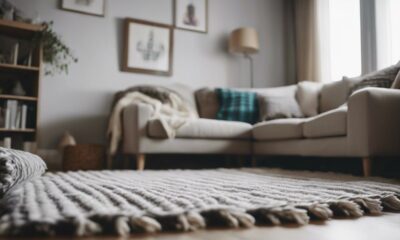
 Decorative Throws2 weeks ago
Decorative Throws2 weeks agoCan I Use a Throw Blanket as a Rug
-
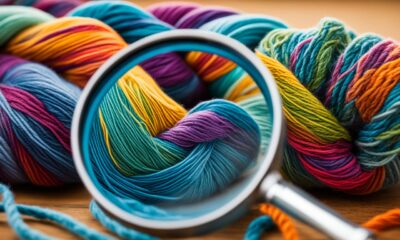
 Yarn2 weeks ago
Yarn2 weeks agoUnravel the Mystery: Why Are Yarn Specs a Secret?
-

 Craft and Textiles2 weeks ago
Craft and Textiles2 weeks ago15 Best Battery-Powered Leaf Blowers for Effortless Yard Work
-

 Tableware and Dining Accessories2 weeks ago
Tableware and Dining Accessories2 weeks agoWhat Is the Meaning of the Word Tableware
-

 Craft and Textiles2 weeks ago
Craft and Textiles2 weeks ago15 Best Toast Recipes to Start Your Day Right















